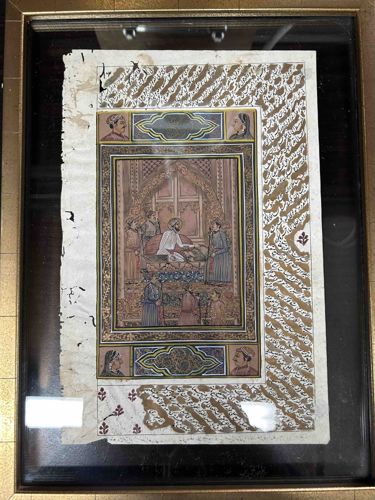
Persian or Mughal Miniature Painting of a Court Scene
This item is a framed miniature painting, likely from the Persian or Mughal tradition, depicting a courtly or royal scene. The painting is presented in a modern gold-toned frame with a black inner border, under glass, suggesting it is well-preserved but also indicating some attempts at contemporary display. The central image features several figures within an architectural setting, possibly a palace interior. A prominent figure, seemingly a ruler, is seated on an elevated platform or throne, surrounded by attendants or courtiers. The color palette includes reds, blues, greens, and ochre tones, characteristic of miniature paintings from the region and era. Gold accents are visible in the detailing of the architecture and possibly on the figures' attire. The central painting is bordered by decorative panels. Above and below the central scene are smaller portrait vignettes, depicting individual figures, possibly important personages or patrons. The most striking feature of this piece is the extensive calligraphic border that surrounds the central painting and portrait vignettes. This border consists of intricate script, possibly Nastaliq, written in white on a golden, patterned background, suggesting verses of poetry, religious text, or an inscription related to the scene. The paper on which the artwork is executed appears to be aged, with visible signs of wear, tearing, and discoloration along the edges, particularly on the left side and in the bottom left corner. This wear indicates the age of the document and its handling over time. The craftsmanship is evident in the fine detail of the figures, the patterns on the textiles and architecture, and the delicate calligraphy. The arrangement of the central scene with surrounding borders, including calligraphic text and smaller portraits, is typical of illuminated manuscripts or standalone album pages from the Safavid or Mughal periods. The presence of these details points to a significant cultural and historical artifact, likely dating from the 17th to 19th centuries, though a more precise dating would require expert analysis of the stylistic elements and text.
AI-Generated Appraisal Disclaimer
Estimated Value
$3,000-5,000
Basic Information
Category
Fine Art
Appraised On
December 7, 2025
Estimated Value
$3,000-5,000
Item Description
This item is a framed miniature painting, likely from the Persian or Mughal tradition, depicting a courtly or royal scene. The painting is presented in a modern gold-toned frame with a black inner border, under glass, suggesting it is well-preserved but also indicating some attempts at contemporary display. The central image features several figures within an architectural setting, possibly a palace interior. A prominent figure, seemingly a ruler, is seated on an elevated platform or throne, surrounded by attendants or courtiers. The color palette includes reds, blues, greens, and ochre tones, characteristic of miniature paintings from the region and era. Gold accents are visible in the detailing of the architecture and possibly on the figures' attire. The central painting is bordered by decorative panels. Above and below the central scene are smaller portrait vignettes, depicting individual figures, possibly important personages or patrons. The most striking feature of this piece is the extensive calligraphic border that surrounds the central painting and portrait vignettes. This border consists of intricate script, possibly Nastaliq, written in white on a golden, patterned background, suggesting verses of poetry, religious text, or an inscription related to the scene. The paper on which the artwork is executed appears to be aged, with visible signs of wear, tearing, and discoloration along the edges, particularly on the left side and in the bottom left corner. This wear indicates the age of the document and its handling over time. The craftsmanship is evident in the fine detail of the figures, the patterns on the textiles and architecture, and the delicate calligraphy. The arrangement of the central scene with surrounding borders, including calligraphic text and smaller portraits, is typical of illuminated manuscripts or standalone album pages from the Safavid or Mughal periods. The presence of these details points to a significant cultural and historical artifact, likely dating from the 17th to 19th centuries, though a more precise dating would require expert analysis of the stylistic elements and text.
Get Your Items Appraised
Instant estimates of your treasures with AI-powered instant appraisals